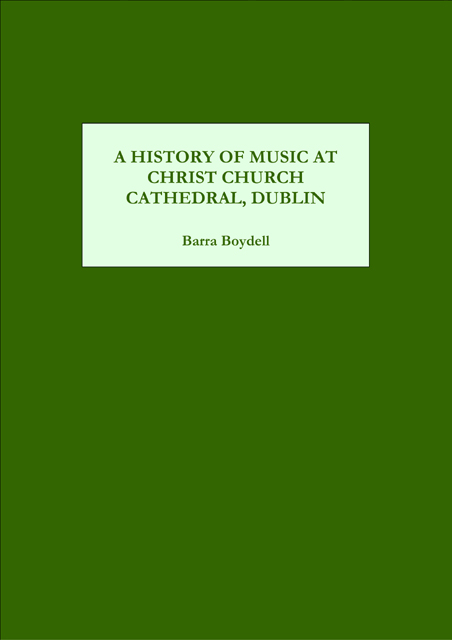Book contents
- Frontmatter
- Contents
- Plates and Musical Examples
- Foreword
- Preface
- Editorial Conventions
- Introduction
- One ‘Dulces Fecit Modos’: The Medieval Cathedral-Priory
- Two ‘For the More Honour of God’s Divine Service’: The Reformation and Early Seventeenth Century
- Three “So Great and Solemn Service’: The Restoration and Later Seventeenth Century
- Four ‘The Increasing Excellence of the Choir’: The Eighteenth and Early Nineteenth Centuries
- Five ‘A More Efficient Performance of the Duties of the Choir’: The Mid-Nineteenth Century
- Six Decline and Revival: Disestablishment and the Twentieth Century
- Appendix One Succession Lists of Organists and Assistant Organists
- Appendix Two Succession List of Masters of the Boys/Music Masters/Choir Masters
- Abbreviations and Bibliography
- Index
Introduction
Published online by Cambridge University Press: 21 March 2023
- Frontmatter
- Contents
- Plates and Musical Examples
- Foreword
- Preface
- Editorial Conventions
- Introduction
- One ‘Dulces Fecit Modos’: The Medieval Cathedral-Priory
- Two ‘For the More Honour of God’s Divine Service’: The Reformation and Early Seventeenth Century
- Three “So Great and Solemn Service’: The Restoration and Later Seventeenth Century
- Four ‘The Increasing Excellence of the Choir’: The Eighteenth and Early Nineteenth Centuries
- Five ‘A More Efficient Performance of the Duties of the Choir’: The Mid-Nineteenth Century
- Six Decline and Revival: Disestablishment and the Twentieth Century
- Appendix One Succession Lists of Organists and Assistant Organists
- Appendix Two Succession List of Masters of the Boys/Music Masters/Choir Masters
- Abbreviations and Bibliography
- Index
Summary
Religious and historical background
Cathedrals have long held a special place not only in the religious but also in the social and cultural lives of the cities of which they have formed such prominent architectural features since medieval times. Since the Reformation English cathedrals have also symbolised secular authority and the political establishment through the intimate association established by Henry VIII between church and monarchy. This association would manifest itself in cathedral music particularly between the later sixteenth and eighteenth centuries when the Chapel Royal provided the musical model which cathedrals sought to emulate. The study of music within the Anglican cathedral tradition therefore not only embraces matters of musical concern, but also draws on the broader social, cultural, and political environments within which the cathedrals have developed and evolved. Irish cathedrals of the Anglican tradition however differ in significant respects from their British counterparts. Although sharing essentially the same traditions, liturgy and structures as the Church of England, the Church of Ireland has always occupied a very different position in terms of its relationship with Irish society. Whereas the Church of England is a national religion representing the majority of the population, the Church of Ireland has never embraced more than a small minority of the Irish people despite wielding a disproportionate influence throughout much of its history and having custodianship of all the country’s surviving medieval cathedrals. The reasons for this anomalous situation can be traced back to the sixteenth century.
The Reformation coincided in Ireland with a more aggressive policy of conquest and settlement by England than had previously been the case. Protestantism became closely identified with English control and settlement, and instead of the country as a whole adopting the religion of its rulers, as was the case elsewhere in Europe after the Reformation, religion largely became a signifier of political and ethnic difference. Churches and cathedrals were anglicised and the public practice of Catholicism prohibited. The majority Catholic population was subjected to increasing repression and expected to worship in the established church. By the later seventeenth and early eighteenth centuries the penal laws had been enacted whereby Catholics were excluded from public office and prohibited from owning land and having a political voice, a situation which encouraged the pragmatic conversion to Protestantism of a number of Gaelic landowners.
- Type
- Chapter
- Information
- Publisher: Boydell & BrewerPrint publication year: 2004



